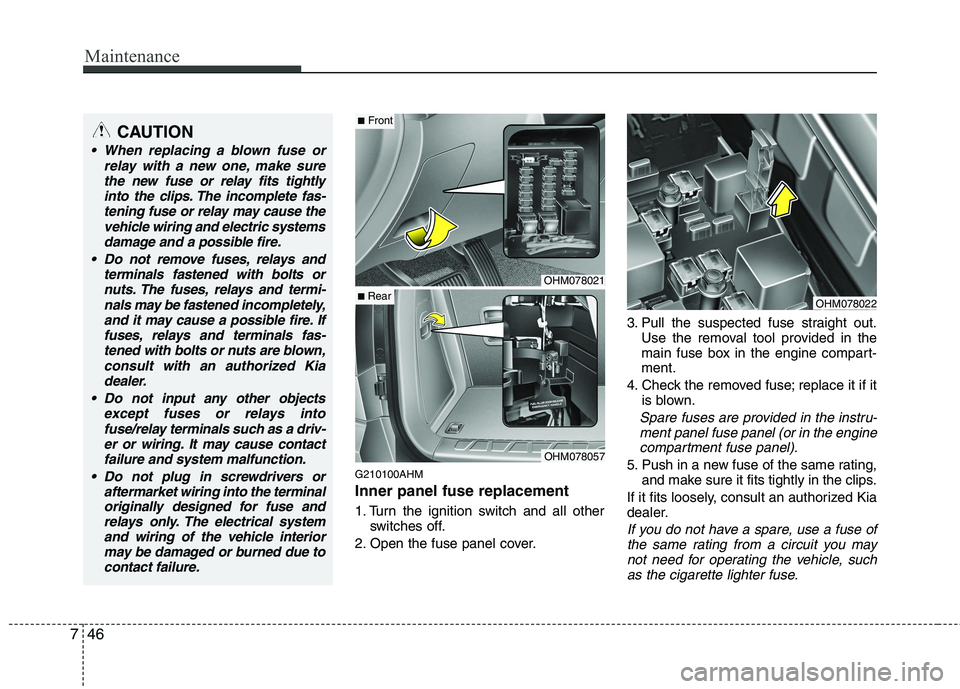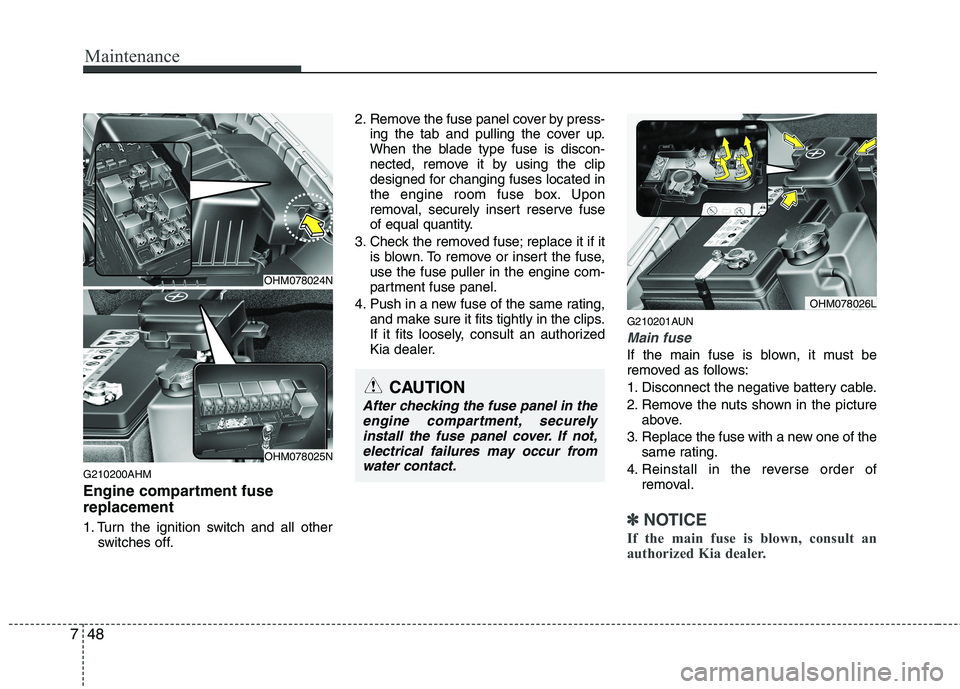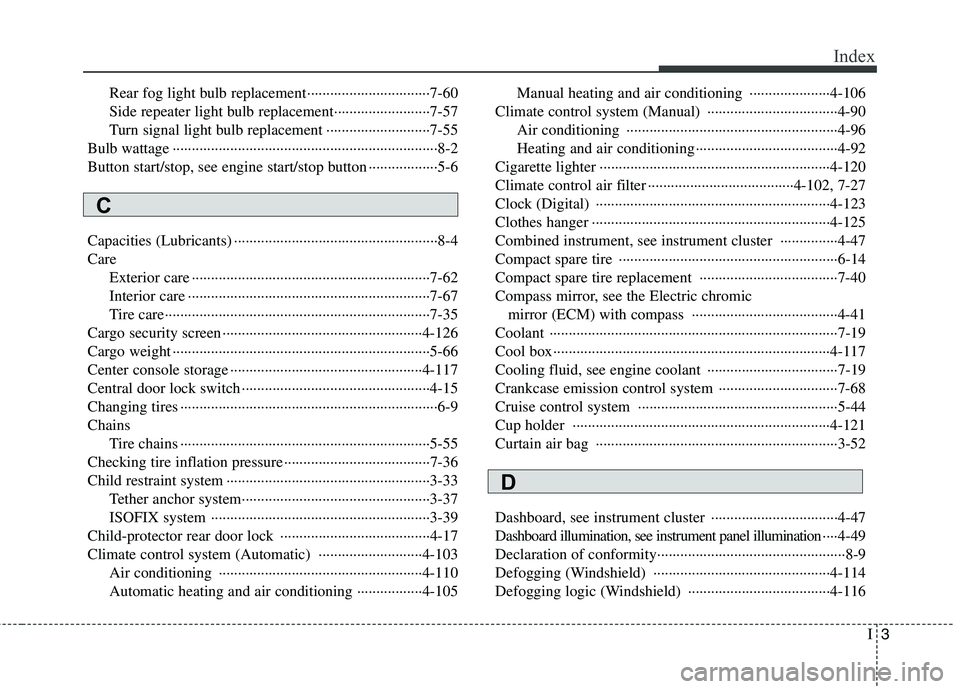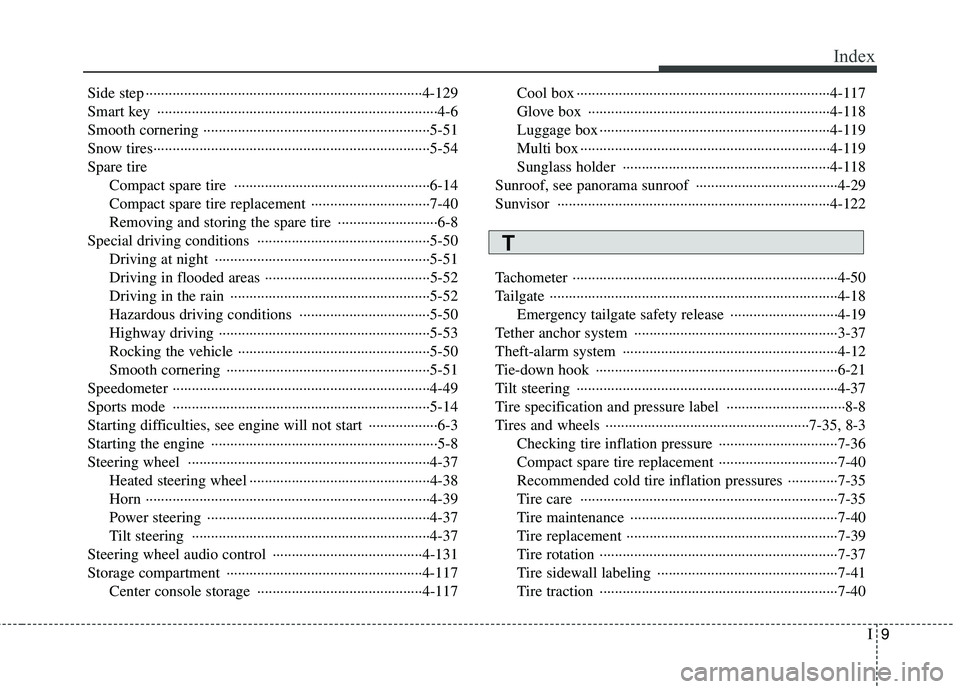check engine KIA BORREGO 2015 Repair Manual
[x] Cancel search | Manufacturer: KIA, Model Year: 2015, Model line: BORREGO, Model: KIA BORREGO 2015Pages: 420, PDF Size: 41.56 MB
Page 375 of 420

745
Maintenance
FUSES
G210000CHM
A vehicle’s electrical system is protected
from electrical overload damage by
fuses. This vehicle has 5 fuse panels, one locat-
ed in the driver’s side panel bolster, the
others in the engine compartment and
luggage compartment.
If any of your vehicle’s lights, acces-
sories, or controls do not work, check the
appropriate circuit fuse. If a fuse has
blown, the element inside the fuse willmelt.
If the electrical system does not work,
first check the driver’s side fuse panel.
Before replacing a blown fuse, discon-
nect the negative battery cable.
Always replace a blown fuse with one of
the same rating.
If the replacement fuse blows, this indi-
cates an electrical problem. Avoid using
the system involved and immediately
consult an authorized Kia dealer.
Three kinds of fuses are used: blade type
for lower amperage rating, cartridge type, and fusible link for higher amperage rat-ings.
✽✽ NOTICE
The actual fuse/relay panel label may
differ from equipped items.
1VQA4037
Normal
Normal
Blade type
Cartridge type
Fusible link Blown
Blown
Normal Blown
WARNING - Fuse replace-
ment
Never replace a fuse with any- thing but another fuse of the same rating.
A higher capacity fuse could cause damage and possibly a
fire.
Never install a wire or aluminum foil instead of the proper fuse -
even as a temporary repair. It may
cause extensive wiring damage
and a possible fire.
Do not arbitrarily modify or add-on electric wiring of the vehicle.
CAUTION
Do not use a screwdriver or any
other metal object to remove fuses
because it may cause a short circuit and damage the system.
Page 376 of 420

Maintenance
46
7
G210100AHM Inner panel fuse replacement
1. Turn the ignition switch and all other
switches off.
2. Open the fuse panel cover. 3. Pull the suspected fuse straight out.
Use the removal tool provided in the
main fuse box in the engine compart-ment.
4. Check the removed fuse; replace it if it is blown.
Spare fuses are provided in the instru-
ment panel fuse panel (or in the engine compartment fuse panel).
5. Push in a new fuse of the same rating, and make sure it fits tightly in the clips.
If it fits loosely, consult an authorized Kia
dealer.
If you do not have a spare, use a fuse of the same rating from a circuit you may not need for operating the vehicle, such as the cigarette lighter fuse.
OHM078022
OHM078021
OHM078057
■ Front
■ Rear
CAUTION
When replacing a blown fuse or
relay with a new one, make surethe new fuse or relay fits tightlyinto the clips. The incomplete fas-tening fuse or relay may cause the vehicle wiring and electric systemsdamage and a possible fire.
Do not remove fuses, relays and terminals fastened with bolts ornuts. The fuses, relays and termi-nals may be fastened incompletely, and it may cause a possible fire. Iffuses, relays and terminals fas-tened with bolts or nuts are blown,consult with an authorized Kia dealer.
Do not input any other objects except fuses or relays intofuse/relay terminals such as a driv-er or wiring. It may cause contactfailure and system malfunction.
Do not plug in screwdrivers or aftermarket wiring into the terminaloriginally designed for fuse and relays only. The electrical systemand wiring of the vehicle interior
may be damaged or burned due tocontact failure.
Page 377 of 420

747
Maintenance
If the headlights or other electrical com-
ponents do not work and the fuses are
OK, check the fuse panel in the engine
compartment. If a fuse is blown, it mustbe replaced.G210101AHM
Memory fuse (SHUNT connector)
Your vehicle is equipped with a memory
fuse (SHUNT connector) to prevent bat-
tery discharge if your vehicle is parked
without being operated for prolonged
periods. Use the following procedures
before parking the vehicle for prolonged
periods.
1. Turn off the engine.
2. Turn off the headlights and tail lights.
3. Open the driver’s side panel cover andpull out the memory fuse (SHUNT connector).
✽✽ NOTICE
If the memory fuse is pulled out from the fuse panel, the warning chime,
audio, clock and interior lamps, etc.,
will not operate. Some items must be
reset after replacement. Refer to
“Battery” in this section.
Even though the memory fuse is
pulled out, the battery can still be dis-
charged by operation of the head-
lights or other electrical devices.
OHM078023
Page 378 of 420

Maintenance
48
7
G210200AHM
Engine compartment fuse replacement
1. Turn the ignition switch and all other
switches off. 2. Remove the fuse panel cover by press-
ing the tab and pulling the cover up.
When the blade type fuse is discon-
nected, remove it by using the clip
designed for changing fuses located in
the engine room fuse box. Upon
removal, securely insert reserve fuse
of equal quantity.
3. Check the removed fuse; replace it if it is blown. To remove or insert the fuse,use the fuse puller in the engine com-
partment fuse panel.
4. Push in a new fuse of the same rating, and make sure it fits tightly in the clips.
If it fits loosely, consult an authorized
Kia dealer. G210201AUN
Main fuse
If the main fuse is blown, it must be
removed as follows:
1. Disconnect the negative battery cable.
2. Remove the nuts shown in the picture
above.
3. Replace the fuse with a new one of the same rating.
4. Reinstall in the reverse order of removal.
✽✽ NOTICE
If the main fuse is blown, consult an
authorized Kia dealer.
CAUTION
After checking the fuse panel in the engine compartment, securely install the fuse panel cover. If not,electrical failures may occur from
water contact.
OHM078026L
OHM078024N
OHM078025N
Page 399 of 420

769
Maintenance
G270201AUN
Canister
Fuel vapors generated inside the fuel tank are absorbed and stored in the
onboard canister. When the engine is
running, the fuel vapors absorbed in the
canister are drawn into the surge tank
through the purge control solenoid valve. G270202AHM
Purge Control Solenoid Valve (PCSV)
The purge control solenoid valve is con-
trolled by the Engine Control Module
(ECM); when the engine coolant temper-
ature is low during idling, the PCSV clos-
es so that evaporated fuel is not taken
into the engine. After the engine warms
up during ordinary driving, the PCSV
opens to introduce evaporated fuel to the
engine.G270300AUN
3. Exhaust emission control
system
The Exhaust Emission Control System is
a highly effective system which controls
exhaust emissions while maintaining
good vehicle performance.
G270301BUN
Vehicle modifications
This vehicle should not be modified.
Modification of your vehicle could affect
its performance, safety or durability and
may even violate governmental safety
and emissions regulations.
In addition, damage or performance
problems resulting from any modification
may not be covered under warranty.
If you use unauthorized electronic devices, it may cause the vehicle to
operate abnormally, wire damage, bat-
tery discharge and fire. For your safety,
do not use unauthorized electronic
devices. G270302AUN
Engine exhaust gas precautions
(carbon monoxide)
Carbon monoxide can be present with other exhaust fumes. Therefore, if you
smell exhaust fumes of any kind inside
your vehicle, have it inspected and
repaired immediately. If you ever sus-
pect exhaust fumes are coming into
your vehicle, drive it only with all the
windows fully open. Have your vehicle
checked and repaired immediately.
WARNING - Exhaust
Engine exhaust gases contain car-
bon monoxide (CO). Though color-
less and odorless, it is dangerousand could be lethal if inhaled.
Follow the instructions on this
page to avoid CO poisoning.
Page 401 of 420

771
Maintenance
Diesel Particulate Filter (if equipped)
The Diesel Particulate Filter (DPF) sys-
tem removes the soot emitted from the
vehicle.
Unlike a disposable air filter, the DPF
system automatically burns (oxidizes)
and removes the accumulated soot
according to the driving condition. In
other words, the active burning by engine
control system and high exhaust gas
temperature caused by normal/high driv-
ing condition burns and removes the
accumulated soot.
However, if the vehicle continues to be
driven at low speed for long time, the
accumulated soot may not be automati-
cally removed because of low exhaust
gas temperature. In this particular case,the amount of soot is out of detection
limit, the soot oxidation process by
engine control system may not happen
and the malfunction indicator light may
blink. When the malfunction indicator light
blinks, it may stop blinking by driving the
vehicle at more than 60 km/h (37 mph) orat more than second gear with 1500 ~
2000 engine rpm for a certain time (for
about 25 minutes).If the malfunction indicator light contin-
ues to be blinked in spite of the proce-
dure, please visit an authorized Kia deal-
er and then check the DPF system.
If you continue to drive with the malfunc-
tion indicator light blinking for a long time,the DPF system can be damaged and
fuel consumption can be worsen.
CAUTION -
Diesel Fuel
(if equipped with DPF)
It is recommended to use the regu- lated automotive diesel fuel fordiesel vehicle equipped with the
DPF system.
If you use diesel fuel including highsulfur (more than 50 ppm sulfur)and unspecified additives, it can cause the DPF system to be dam-
aged and white smoke can be emit-ted.
Page 407 of 420

Specifications & Consumer information
6
8
I040100DUN Recommended SAE viscosity
number
Engine oil viscosity (thickness) has an
effect on fuel economy and cold weather
operating (engine start and engine oil
flowability). Lower viscosity engine oils can
provide better fuel economy and cold
weather performance, however, higher vis-
cosity engine oils are required for satisfac-
tory lubrication in hot weather. Using oils of
any viscosity other than those recom-
mended could result in engine damage.
CAUTION
Always be sure to clean the area
around any filler plug, drain plug, or
dipstick before checking or drain-ing any lubricant. This is especiallyimportant in dusty or sandy areas
and when the vehicle is used on unpaved roads. Cleaning the plugand dipstick areas will prevent dirt and grit from entering the engine and other mechanisms that could
be damaged.
When choosing an oil, consider the range of temperature your vehicle will be operated in
before the next oil change. Proceed to select the recommended oil viscosity from the chart.
Temperature Range for SAE Viscosity Numbers
Temperature
Gasoline Engine Oil
(Except Middle East* 1
)
Gasoline Engine Oil (For Middle East* 1
)
°C
(°F)-30 -20 -10 0 10 20 30 40 50 -10 0 20 40 60 80 100 120
*1
: Middle East includes India, Libya, Algeria, Morocco, Tunisia, Sudan, Egypt and Iran.
* 2
: For better fuel economy, it is recommended to use the engine oil of a viscosity grade SAE
5W-20(API SM / ILSAC GF-4). However, if the engine oil is not available in your country,
select the proper engine oil using the engine oil viscosity chart.
* 3
: For better fuel economy, it is recommended to use the engine oil of a viscosity grade SAE
5W-30(ACEA A5). However, if the engine oil is not available in your country, select the prop-
er engine oil using the engine oil viscosity chart.
* 4
: It is only for extreme cold area and to be restricted by driving condition and area.
(Especially, not recommended for sustained high loaded and high speed operation.)
20W-50
10W-30
15W-40
5W-20 * 2
, 5W-30
20W-50
10W-30
15W-40
5W-30 * 3
, 5W-40
Diesel Engine Oil5W-30
15W-40
10W-30
0W-30 *4
Page 413 of 420

I3
Index
Rear fog light bulb replacement································7-60
Side repeater light bulb replacement·························7-57
Turn signal light bulb replacement ···························7-55
Bulb wattage ·····································································8-2
Button start/stop, see engine start/stop button ··················5-6
Capacities (Lubricants) ·····················································8-4 Care Exterior care ······························································7-62
Interior care ·······························································7-67
Tire care·····································································7-35
Cargo security screen ····················································4-126
Cargo weight ···································································5-66
Center console storage ··················································4-117
Central door lock switch ·················································4-15
Changing tires ···································································6-9Chains Tire chains ·································································5-55
Checking tire inflation pressure ······································7-36
Child restraint system ·····················································3-33 Tether anchor system·················································3-37
ISOFIX system ·························································3-39
Child-protector rear door lock ·······································4-17
Climate control system (Automatic) ···························4-103 Air conditioning ·····················································4-110Automatic heating and air conditioning ·················4-105 Manual heating and air conditioning ·····················4-106
Climate control system (Manual) ··································4-90 Air conditioning ·······················································4-96
Heating and air conditioning ·····································4-92
Cigarette lighter ····························································4-120
Climate control air filter ······································4-102, 7-27
Clock (Digital) ·····························································4-123
Clothes hanger ······························································4-125
Combined instrument, see instrument cluster ···············4-47
Compact spare tire ·························································6-14
Compact spare tire replacement ····································7-40
Compass mirror, see the Electric chromic mirror (ECM) with compass ······································4-41
Coolant ···········································································7-19
Cool box········································································4-117
Cooling fluid, see engine coolant ··································7-19
Crankcase emission control system ·······························7-68
Cruise control system ····················································5-44
Cup holder ···································································4-121
Curtain air bag ·······························································3-52
Dashboard, see instrument cluster ·································4-47
Dashboard illumination, see instrument panel illumination ····4-49
Declaration of conformity·················································8-9
Defogging (Windshield) ··············································4-114
Defogging logic (Windshield) ·····································4-116
C
D
Page 419 of 420

I9
Index
Side step ········································································4-129
Smart key ·········································································4-6
Smooth cornering ···························································5-51
Snow tires········································································5-54Spare tire
Compact spare tire ···················································6-14
Compact spare tire replacement ·······························7-40
Removing and storing the spare tire ··························6-8
Special driving conditions ·············································5-50 Driving at night ························································5-51
Driving in flooded areas ···········································5-52
Driving in the rain ····················································5-52
Hazardous driving conditions ··································5-50
Highway driving ·······················································5-53
Rocking the vehicle ··················································5-50
Smooth cornering ·····················································5-51
Speedometer ···································································4-49
Sports mode ···································································5-14
Starting difficulties, see engine will not start ··················6-3
Starting the engine ···························································5-8
Steering wheel ·······························································4-37 Heated steering wheel ···············································4-38Horn ··········································································4-39
Power steering ··························································4-37
Tilt steering ······························································4-37
Steering wheel audio control ·······································4-131
Storage compartment ···················································4-117 Center console storage ···········································4-117 Cool box ··································································4-117
Glove box ·······························································4-118
Luggage box ····························································4-119
Multi box ·································································4-119
Sunglass holder ······················································4-118
Sunroof, see panorama sunroof ·····································4-29
Sunvisor ·······································································4-122
Tachometer ·····································································4-50
Tailgate ···········································································4-18 Emergency tailgate safety release ····························4-19
Tether anchor system ·····················································3-37
Theft-alarm system ························································4-12
Tie-down hook ·······························································6-21
Tilt steering ····································································4-37
Tire specification and pressure label ·······························8-8
Tires and wheels ·····················································7-35, 8-3 Checking tire inflation pressure ·······························7-36
Compact spare tire replacement ·······························7-40
Recommended cold tire inflation pressures ·············7-35
Tire care ···································································7-35
Tire maintenance ······················································7-40
Tire replacement ·······················································7-39
Tire rotation ······························································7-37
Tire sidewall labeling ···············································7-41
Tire traction ······························································7-40
T